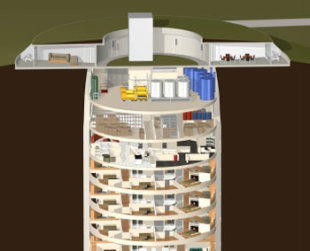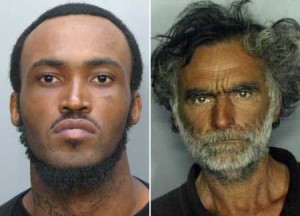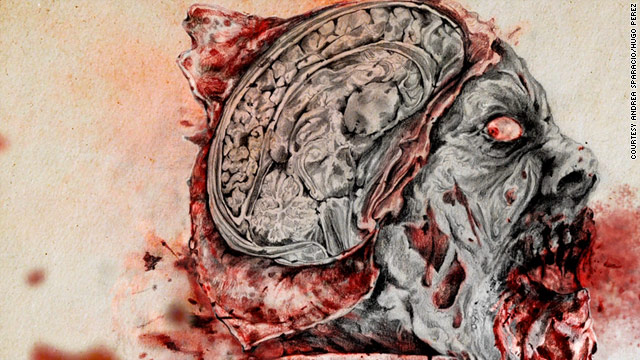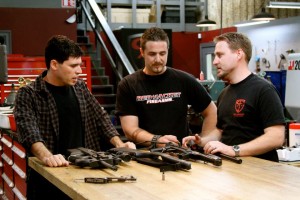Tag Archives: target
Zombie-proof condos all sold out in Kansas, Canadians still have options
The units built out of an old missile silo had a list price of $2 million
If you are looking for something to protect yourself when zombies attack, we may have found just the abode for you. The only problem: the zombie-proof condos in Kansas have all sold out.
found just the abode for you. The only problem: the zombie-proof condos in Kansas have all sold out.
According to the Survival Condo website, all eight units have been purchased, although one sale is still pending.
The 1,820-square-foot condos come with an indoor pool (definitely not above ground) and spa, exercise facility, classroom, library, movie threatre, minor surgery centre and an elevator. Owners also get off-the-grid power thanks to a wind turbine and solar panels. Next to the sold notice, the website also states that they “now have an in-house dentist/orthodontist!!!!” on level 3a. Oh and did we mention it comes with a weapons cache.
All of this went for $2 million for a full floor.
The place was rated by Mother Nature Network as one of the “best U.S. places to survive the apocalypse.”
The condos weren’t dug into the ground, but are made from an old missile silo in Concordia, Kansas. The silo was build to withstand a nuclear explosion and according to Rocket City News is considered to be “one of the strongest structures built by man.”
“Construction is well under way,” reads the Survival Condo website. “The new steel structure is built and the top five floors are poured and being built out for the owners. The new septic system is complete and the new water system is nearing completion.”
If you weren’t one of the people who were able to purchase a zombie-proof home, the B.C. government has put together some advice on fending off the brain eaters. It recommends having a full gas tank, having an emergency kit in your home, office and car and having an out-of-province contact.
It launched a blog on the Emergency Info BC website in May to tell people what to do in case of a real emergency such as an earthquake, flood or tsunami.
A recent survey found nine per cent of Canadians believe the Mayan prediction that the world will end in 2012. In the event this minority’s belief is correct, escaping into a bunker is an option in Canada. Bruce Beach has built the world’s largest privately-constructed nuclear fallout shelter in Horning’s Mills, Ont., about an hour and a half from Toronto. It’s called Ark Two. The shelter is constructed from the shells of 42 school buses, which were buried underground in the 1980s as moulds for the poured concrete bunker.
(Image from Survival Condo)
Troubled lives clashed in ‘Miami zombie’ face-eating attack
 MIAMI — Saturday’s horror-movie episode on Miami’s MacArthur Causeway brought together two troubled men, one who was struggling to get his life on track, another who’d given up trying.
MIAMI — Saturday’s horror-movie episode on Miami’s MacArthur Causeway brought together two troubled men, one who was struggling to get his life on track, another who’d given up trying.
Rudy Eugene, 31, had been seeking spiritual guidance in Scripture. On May 24, two days before he would viciously attack a homeless man named Ronald Edward Poppo, Eugene attended a Bible-study session at a friend’s North Miami Beach home.
Recently, Eugene posted a verse from Psalm 59 on his Facebook page: “Deliver me from my enemies, O my Lord; Defend me from those who rise up against me. For the Lord God is my defense. …”
Friend Bobby Chery said he, Eugene and another friend discussed that day what they could do to become better men according to the word of God, and that Eugene vowed to give up marijuana.
That same Thursday, Miami Police rousted Poppo from one of the last places he called home: the top floor of the parking garage at Jungle Island, the Watson Island botanical and wildlife attraction.
Outreach workers from the Miami Homeless Assistance Program found him there and offered help, said Ronald Book, chairman of the Miami-Dade County Homeless Trust.
But after Poppo became “belligerent and aggressive,” the outreach team called police. Officers issued Poppo, who had turned 65 a week earlier, a “trespassing after warning” citation.
“He grabbed his box of stuff and went off,” said Book. Outreach workers reported he was “cursing and claiming discrimination.”
About 2 p.m. on Saturday, a naked Rudy Eugene grabbed Poppo near the causeway’s west end, stripped off his clothes, beat him, bit him, and gnawed off his face.
More than 15 minutes into the attack, a police officer arrived and shot Eugene to death. Poppo remains in critical condition at Jackson Memorial Hospital’s Ryder Trauma Center.
The crazed assault shocked nearly everyone who knew Eugene.
Johansen Aurelus, a childhood friend, called Eugene “preacher” because he liked sharing Bible verses with friends and kept his Bible handy.
Aurelus attended Bethel Baptist Church with Eugene when they were teens. Back then, Aurelus said, Eugene would ask questions about the pastor’s sermons and how they applied to his life.
Over the years Rudy had some run-ins with the police for marijuana possession and a domestic dispute. Most recently, he had difficulty holding a job, friends say.
Eugene’s stepfather, Melimon Charles, of North Miami, said that Eugene “is not the kind of devil who goes out and kill people like they are showing on the news. He’s a fine boy. He was raised in the church. He was in the choir.”
Trouble may have started about the time Eugene learned Melimon was not his biological father, in ninth or tenth grade, although Melimon had been with Eugene’s mom Ruth since the boy was 2.
Rudy “was angry because he was looking for his father,” Charles said. “His father passed away and he didn’t know. And I didn’t know anything about it. I didn’t even have a picture to show him.”
Soon after, he said, Eugene accepted “the truth and we were doing fine.”
But at 17, Eugene moved out of his home, without telling his stepfather. He transferred from North Miami Beach High School to North Miami High.
If he was upset over “family issues,” it was because of his parents’ divorce, which happened after he was an adult, Charles said.
Charles dismisses gossip that Rudy was the target of a voodoo curse.
“Nobody went to Haiti and did anything to him,” he insisted.
Though Eugene had stopped attending church regularly, he maintained his quest for spirituality. He regularly sent inspirational text messages to his friends. And on Facebook, he mentions “Zoe Life” several times — a phrase both associated with Haitian life and with born-again Christians.
His final post, on May 18, proclaimed: “ZOE LIFE IS ETERNAL!!!!!!!!!”
Friends posted tributes on his page.
“Damn, I still can’t believe it, out of all people, YOU! You have been a great friend to me, and for that you will always be missed!” said Meli Mel Rivera.
Ranessia Rollins posted that Eugene was at her house on Friday and kissed her cheek.
All of his friends expressed disbelief and solidarity.
Pudding Sabali said: “They’re telling me (us) that we shouldn’t have any grief for you dying. But it’s hard to not have the deepest warm feeling when it comes to you … just a young man misunderstood … God have mercy on your soul.”
Understanding Ronald Poppo is harder because he lived anonymously for so long.
Ron Book said that outreach workers had been offering him services since Dec. 27, 1999. At the time, he said he hadn’t lived at a permanent address since 1970.
Poppo said he’d become homeless outside of Florida, slept on Watson Island and abused alcohol.
He stayed in an emergency shelter for 141 days, during which he saw a counselor once, according to assistance program records.
Four years later, Miami police took him back to the shelter. Starting on Oct. 6, 2003, Poppo stayed for 10 days, and again met once with a counselor.
Between that stay and his last encounter with outreach workers on May 24th, Poppo may have spent less than a week living inside.
Records show he stayed twice at Camillus House in 2004, on Jan. 26 and July 20, and once at the Homeless Assistance Center on Nov. 16. His last stay: Jan. 23, 2005, under a cold weather sheltering program.
On Nov. 11, 2004, some kind of “mental crisis” brought him to Jackson’s crisis intervention unit, but an assistance program report is unclear about whether he stayed overnight.
Outreach teams approached him three times in 2005 and 2006, but he refused help.
“During one of the contacts he became angry and started throwing rocks at the outreach staff,” Book said.
Among Miami’s 240 to 260 chronic homeless people, “sometimes after three, 10, 30 attempts, we get a guy or woman to come in,” Book said. “There are people for different reasons, it takes them that long, maybe never, to get off the streets.”
Details of Poppo’s life have been surfacing in bits since the assault. The 1964 graduate of New York’s elite Stuyvesant High School grew up in Brooklyn, according to long-lost sister Antoinette Poppo.
Neither she nor Poppo’s two brothers have seen him in more than 30 years, she said, and none of them plan a trip to Miami. Two siblings live in New York, another in California.
Their late father was a shipfitter, she said, a structural worker in a shipyard. She believes that “Ronnie” attended both parents’ funerals.
She couldn’t explain the conditions that led to her brother’s downward spiral and his estrangement from the family.
“I’m 12 years older,” she said. “He was 6 years old when I got married and left the house.”
But she called him “a very intelligent boy and a gentle person.”
For a time in the late ’80s, Poppo worked as a roadie for the band SKUM, which spent about two years in Miami before breaking up around 1990.
They’re reuniting for a documentary, said former lead singer Hart Baur, of Miami. He said that part of the band’s philosophy was to hire homeless guys to carry equipment.
In an email from North Carolina, former bass player Patrick Burke, a former Miamian, said band members would see “homeless guys panhandling, so we’d take them to Burger King, and say, ‘You want to work, take out the garbage and sweep up the parking lot?’ ”
They’d give them a few bucks, booze and dinner.
There were moments of lucidity with Poppo, whom he called Ernie, “because I thought he looked like Ernest Hemingway,” Burke said.
Other band members called him Pops, Burke said, because he looked old.
Poppo was hanging out “under a bridge off Biscayne Boulevard” when the band met him, Burke said. “He loved to drink and we used to always kid him about the fact that homeless people always had the best heads of hair. Pops used to say, “It’s just the lifestyle, man — no bad chemicals on my head.”‘
He was always wearing a Yankee cap, Burke said, “and he would take it off to show his locks to the girls at our shows. … Last time I saw him was at the Grove Cinema in 1989.”
On Thursday, the Jackson Memorial Foundation established a fund for Poppo’s care. Foundation spokesman Larry Clark said that “inquiries have come from all over the country.”
Donations can be made on the foundation’s website, www.jmf.org (click the “Take Action Now” tab, and then click on donations. On the donation page, select “other” in the Contribution Details section and write in “Ronald Poppo”).
Donations by check should be sent to Jackson Memorial Foundation, Park Plaza East, Suite G, 901 N.W. 17th Street, Miami, FL 33136.; write “Ronald Poppo” on the memo line.
Inside zombie brains: Sci-fi teaches science

- A new novel “The Zombie Autopsies” is about, well, zombies
- The zombie virus basically eats the brain down to the amygdala
- When it’s humans vs. zombies, the best solution is a strategic attack, mathematician says
Zombie author and expert Dr. Steven Schlozman will join us for a Twitter chat at 12:00 p.m. ET on Tuesday, April 26. Tweet your questions to @cnnhealth and follow along at #cnnzombies.
(CNN) — An airborne virus is rapidly turning people into zombies. Two-thirds of humanity has been wiped out. Scientists desperately look for a cure, even as their own brains deteriorate and the disease robs them of what we consider life.
Relax, it’s only fiction — at least, for now. This apocalyptic scenario frames the new novel “The Zombie Autopsies” by Dr. Steven Schlozman, a child psychiatrist who holds positions at Harvard Medical School and the Massachusetts General Hospital/McLean Program in Child Psychiatry.
You might not expect someone with those credentials to take zombies seriously, but it turns out the undead are a great way to explore real-world health issues: why certain nasty diseases can destroy the brain, how global pandemics create chaos and fear, and what should be done about people infected with a highly contagious and incurable lethal illness.
“One of the things zombie novels do is they bring up all these existential concerns that happen in medicine all the time: How do you define what’s alive?” says Schlozman, who has been known to bounce between zombie fan conventions and academic meetings.
“When is it appropriate to say someone’s ‘as-good-as-dead,’ which is an awful, difficult decision?”
What a zombie virus would do to the brain
So maybe you’ve seen “Night of the Living Dead,” read “World War Z,” or can’t wait for the return of the AMC show “The Walking Dead,” but you probably don’t know what differentiates the brains of humans and zombies.
First things first: How does the zombie disease infect its victims? Many stories in the genre talk about biting, but Schlozman’s novel imagines a deliberately engineered virus whose particles can travel in the air and remain potent enough to jump from one person to another in a single sneeze.
Now, then, to the brain-eating. The zombie virus as Schlozman describes it basically gnaws the brain down to the amygdala, an almond-shaped structure responsible for the “fight or flight” response. The zombies always respond by fighting because another critical part of the brain, the ventromedial hypothalamus, which tells you when you’ve eaten enough, is broken.
The brain’s frontal lobes, responsible for problem-solving, are devoured by the virus, so zombies can’t make complex decisions. Impairment in the cerebellum means they can’t walk well, either. Also, these humanoids have an unexplained predilection for eating human flesh.
“The zombies in this book are stumbling, shambling, hungry as hell,” Schlozman said. “Basically they’re like drunk crocodiles; they’re not smart, they don’t know who you are or what you are.”
Why we love those rotting, hungry, putrid zombies
How a zombie virus would be made
So the bloodthirsty undead wander (or crawl) around spreading a lethal illness ominously called ataxic neurodegenerative satiety deficiency syndrome, or ANSD, for short.
“When something really terrifying comes along, especially in medicine or that has a medical feel to it, we always give it initials. That’s the way we distance ourselves from it,” Schlozman said.
The virus has several brain-destroying components, one of which is a “prion,” meaning a protein like the one that causes mad cow disease. In real life, prions twist when they are in an acidic environment and become dangerous, Schlozman said. How our own environment has changed to make prions infectious — getting from the soil to the cows in mad cow disease, for instance — is still a mystery.
Now here’s something to send chills up your spine: In Schlozman’s world, airborne prions can be infectious, meaning mad cow disease and similar nervous-system destroyers could theoretically spread just like the flu. Swiss and German researchers recently found that mice that had only one minute of exposure to aerosols containing prions died of mad cow disease, as reported in the journal PLoS Pathogens. A follow-up described in Journal of the American Medical Association showed the same for a related disease that’s only found in animals called scrapie. Of course, these are mice in artificially controlled conditions in a laboratory, and humans do not exhale prions, but it could have implications for safety practices nonetheless.
Like mad cow disease, the zombie disease Schlozman describes also progresses in acidic environments. In the book, a major corporation doles out implantable meters that infuse the body with chemicals to artificially lower acidity when it gets too high. But, sadly, when acidity is too low, that also induces symptoms that mimic the zombie virus, so it’s not a longterm solution. Everyone who gets exposed eventually succumbs, Schlozman said.
As for the unknown component of the zombie disease that would help slowly zombifying researchers in their quest for a cure, that’s up for the reader to figure out — and the clues are all in the book, Schlozman said.
How we’d fight back
You can’t ethically round up fellow survivors to kick some zombie butt unless the undead have technically died. And in Schlozman’s book, a group of religious leaders get together and decide that when people reach stage four of the disease, they are basically dead. That, of course, permits zombie “deanimation,” or killing.
The ‘zombie theology’ behind the walking dead
And how do you kill a zombie? Much of zombie fiction knocks out zombies through shots to the head. That, Schlozman said, is because the brain stem governs the most basic functioning: breathing and heartbeat.
A zombie-apocalypse disease like the one he describes probably wouldn’t evolve on its own in the real world, he said.
But, as we’ve seen, individual symptoms of zombies do correspond to real ailments. And if they all came together, the disease would be creepily efficient at claiming bodies, Schlozman said.
Bad news, folks: Even if people contracted a zombie virus through bites, the odds of our survival aren’t great.
A mathematician at the University of Ottawa named Robert Smith? (who uses the question mark to distinguish himself from other Robert Smiths, of course), has calculated that if one zombie were introduced to a city of 500,000 people, after about seven days, every human would either be dead or a zombie.
“We’re in big, big trouble if this ever happens,” Smith? said. “We can kill the zombies a bit, but we’re not very good at killing zombies fundamentally. What tends to happen is: The zombies just win, and the more they win, the more they keep winning” because the disease spreads so rapidly.
The best solution is a strategic attack, rather than an “every man for himself” defense scenario, he said. It would take knowledge and intelligence, neither of which zombies have, to prevail.
Why study zombies?
In his day job, Smith? models how real infectious diseases spread. But he’s already reaped benefits from his work on zombies. For instance, while many mathematical models only deal with one complicated aspect of a situation at a time, he tackled two — zombie infection and zombie-killing — when it came to speculating about outbreaks.
When it came time for modeling of real-world human papillomavirus (HPV), then, Smith? felt equipped to handle many facets of it at the same time, such as heterosexual and homosexual transmission of HPV.
“Knowing what we knew from zombies allowed us to actually take on these more complicated models without fear,” he said.
Studying zombies is also a great way to get young people excited about science. Smith?, who was on a zombie-science panel with Schlozman through the National Academy of Sciences’ Science and Entertainment Exchange in 2009, has also seen math-phobic people get interested in mathematics by reading about his work with zombies.
“There are insights that we gain from the movies, and from fiction, from fun popular culture stuff, that actually can really help us think about the way that science works, and also the way science is communicated,” he said.
And as to why people like reading about zombies and watching zombies so much, Schlozman points to the impersonal nature of things in our society, from waiting in line in the DMV to being placed on hold on a call with a health insurance company.
Think about all the situations in daily life where you sense a general lack of respect for humanity, and zombies make a little more sense.
“The zombies themselves represent a kind of commentary on modernity,” Schlozman says. “We’re increasingly disconnected. That might be the current appeal.”
Real Life Zombies
The thought of our bodies walking around and operating without our personal conscious or as the more spiritual believe without our soul is an idea that has intrigued and captivated the minds of human beings for centuries. Whether it be the living-dead and body snatchers of Hollywood movies or the stories of voodoo priests using potions to turn rivals into mindless drones to do their bidding, myths, movies, and stories about zombies have been a mainstay in human culture. But the idea of our bodies walking around without freewill or after we have passed may be closer to the realm of the natural than we all thought.
We have all been in the situation where we see a hideous bug in our sink or bathtub and instead of squishing it we take a more timid approach and turn the water on and drown the pest. Imagine you try to that and you watch the ugly sucker spin down the drain. You return to the bathroom later to make the horrifying discovery that the bug had returned from the dead. There are two possibilities: either you have a bathroom infested with bugs or you are dealing with a wolf spider, whose appearance is even more terrifying than its name.

